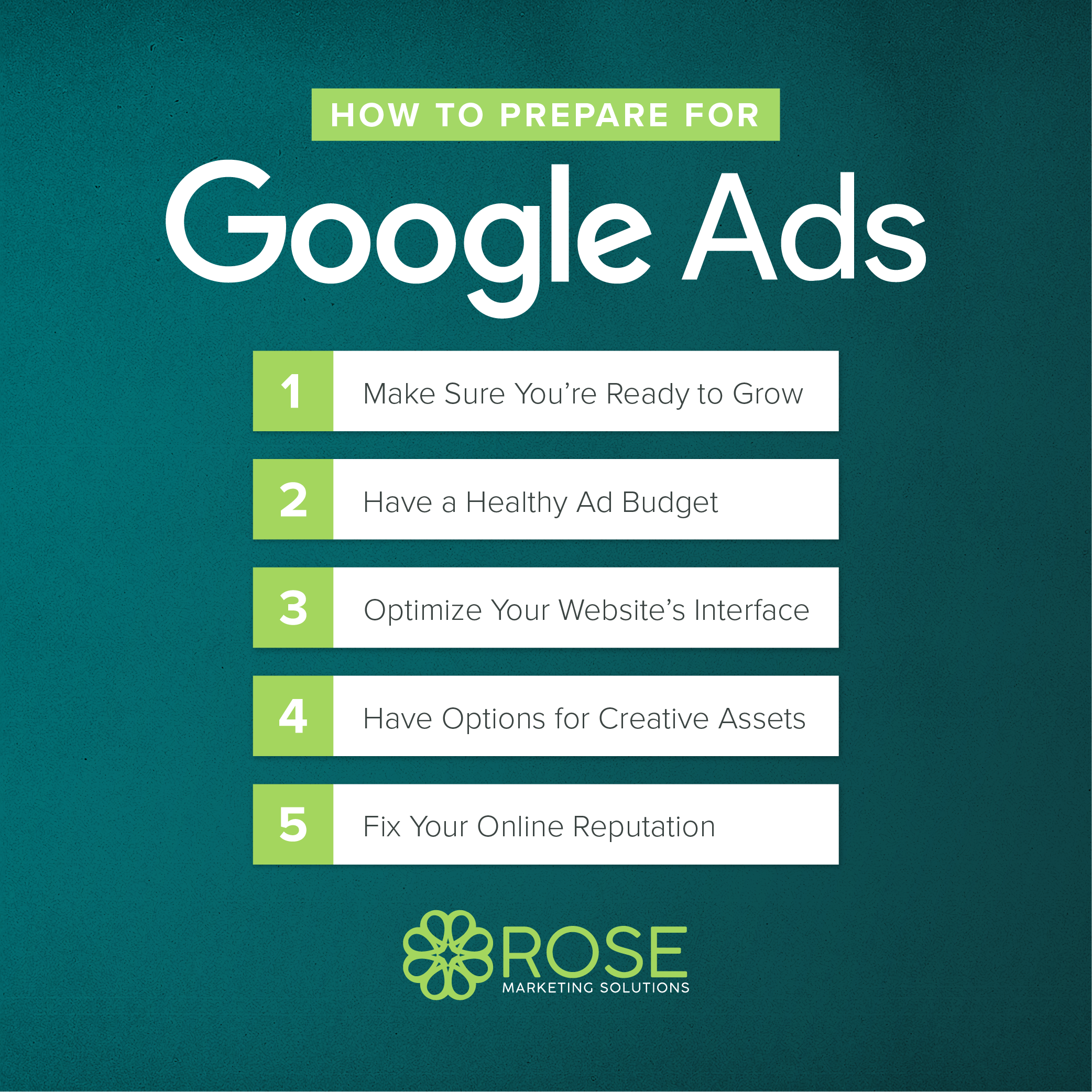Everyone seems to be using Google Ads these days, and many businesses are understandably eager to get started. Maybe they’ve heard inspiring Google Ads success stories. Maybe they have a new website or service to promote. Or maybe a competitor is ramping up ads. Whatever the reason, Google Ads seems like a simple, quick-start solution.
And it is, in a way. But (and that’s a big “but”), Google Ads only works really well if you take a little time to lay the groundwork for it.
So despite the myriad articles online insisting that you MUST start a campaign immediately, pause, take a breath, and walk through our Google Ads Checklist to ensure you get the return you deserve from your investment.
What Happens Without Preparation?
To be clear, we’re not saying you can’t run Google Ads yourself or that setting your ads up needs to be onerous. We simply want to help you avoid the biggest consequences we’ve seen businesses suffer, since a little work on the front end can make all the difference.
The two biggest consequences we see are wasted money and poor ad performance.
Wasted money. Jumping into Google Ads without taking the time to prepare and acquire the knowledge to run it correctly is a guaranteed way to get low return on ad spend (RoAS). Maybe you’ve found an excellent how-to guide for setting up your own Google Ads and you have a healthy budget to throw at a campaign. Regardless, ads simply won’t get you a good return if the proper groundwork isn’t laid, and you’ll lose the money you’ve invested.
Poor performance. The reason behind the poor RoAS mentioned above is poor ad performance. At its core, Google Ads operates according to an algorithm that needs to learn. It needs to learn your business, your target users, and your target audience. When it learns properly, the algorithm points Google users to the right ads. But without the necessary groundwork, the algorithm can’t learn properly, and your ads won’t show up for the right people or in the best placements. They might not even show up at all.
Ten years ago, most businesses did just fine without running any online ads. These days, however, most businesses can’t thrive without a digital presence, and they certainly can’t grow and scale. So rather than regarding this new necessity as a quick experiment or something to “try out,” we suggest viewing it as an investment that deserves time and planning.
Running Google Ads is more than just another marketing tactic. If you approach it like the critical investment it is, you’ll benefit from the results.

Google Ads Checklist: How to Prepare
Google Ads are so ubiquitous that they may not seem to require much to get started. And in a way, they don’t. But if you want to actually benefit from the money you put into them, preparation is key. Walk through our Google Ads Checklist to make sure you’re in position to reap all the benefit from your paid ad campaigns.
1. Make Sure You’re Ready to Grow
The first and most important item in the Google Ads Checklist is making sure your business is ready for growth.
More business than you can handle might sound like one of those “nice problems to have,” but it’s still a problem. What if you run Google Ads today and tomorrow you get five new calls from parents looking to enroll their children? What about 10? Or 30? Will these overwhelm your staff?
The problem here is that in order to catch up and regroup, you may need to pause your ads. After spending all that time and money setting up Google Ads, turning it off is a step backward — because Google’s algorithm does not respond well. Turning off ads stunts the learning of the algorithm, causing your ad performance to suffer.
To avoid Google’s ire, take a look at the resources you currently have and make sure they can handle more before inviting that additional business. Work with your staff to figure out exactly how you’ll handle the kind of growth you want to see. Run scenarios and make a plan. This is the most important place to start your preparations, because Google Ads has the potential to scale a business very quickly when done well.
2. Have a Healthy Ad Budget
It’s not a stretch to say that your Google Ads budget can make or break your efforts. It costs money to run ads, and a reasonably healthy ads budget keeps your ads performing well. Conversely, a budget that’s too low means your ads won’t perform as well and your competitors will effectively overtake your ad space.
For this reason, the second item in the Google Ads Checklist is assessing your financials and making sure you have a healthy ads budget ahead of time. If you don’t, it’s better to wait until you’re able to better fund your ads so that they’ll be competitive and get results.
This doesn’t mean your ad budget has to be outrageous; it should match the market you serve. Ads for a child care center in Katy, Texas will require less expense than ads in the Woodlands. Though these cities are both near Houston, they are different markets with different levels of competition.
This is where an expert can really come in handy. They can take a look at your industry and market, as well as your competitors, and help determine what a healthy budget looks like for you. If you don’t have a place in your budget for ads, it’s okay to wait until you do. And it’s not a bad idea to build in additional budget to invest in an expert when you’re ready.
3. Optimize Your Website’s Interface
Next on the Google Ads Checklist is optimizing your website for your potential customers.
Some of us remember when simply having a website was impressive, but that’s not the case today. Websites are everywhere, and whether we know it or not, the average person has a secret set of standards for how easy a website should be to use.
Your website is your digital representative for future clients and families. So while paid ads can bring you leads, if those leads don’t like what they see or are confused when they land on your site, they won’t convert to sales. That’s why it’s important to track your traffic, leads, and purchases — so you can evaluate what’s working well and what isn’t.
Users expect websites to be fresh, easy to navigate, and optimized for mobile devices. Any service you offer, especially if you run ads for it, should have its own, dedicated page and be easy to find. It helps to read through your pages as an outsider, or ask an actual outsider to do so. Is the information clear? Do you immediately understand what service is being offered? Is the next step obvious?
Taking a look at your top competitors’ websites can provide inspiration and help you identify any blind spots to address on your own. You can also consult a marketing agency for strategic, up-to-date recommendations.
Not everyone has the funds to hire an agency or redesign their entire website, but you can have individual landing pages built that are compatible with Google Ads, keeping the tips in this section in mind.
4. Have Options for Creative Assets
Google Ads require images and related text, and video is fast becoming a necessity to stay competitive as well. These assets can make or break how well your ads compare to others of similar businesses. So the fourth item on the Google Ads Checklist is making sure you have a robust and reliable source for your ad creative.
Depending on the types of ads recommended for your business, you could need up to 20 images, three logo formats, and at least two videos for your ads to be effective. The images and videos can be your own or purchased from stock sites, but you’ll need fresh content available regularly.
Done properly, imaging is extremely compelling and can make the difference between a user clicking on your ad or your competitor’s.
5. Fix Your Online Reputation
The final item on the Google Ads Checklist is fixing your online reputation.
One reality of the internet age is that your reputation will precede you, so make sure it’s a good one. No matter how much time and budget you put into your ads or how closely you follow the rest of this checklist, a poor online reputation will torpedo your efforts.
Parents checking into your services are going to look at online reviews before they move forward. It pays to take the time to respond to negative reviews, maintain an active presence on review sites, and work toward improving your online reputation. This will help the leads you get from paid ads convert into actual revenue.
Know What You Don’t Know by Leveraging an Ads Expert
Running a business is a tough job (if not several tough jobs rolled into one). Google Ads has a steep learning curve that takes much time and effort to climb. For most business owners, this simply doesn’t fit on their already overfilled plate.
It’s a full-time job in and of itself to keep up with the best practices, changes, healthy budgets, ad creative, and other factors involved in running successful Google Ads campaigns. But you need to focus on running your business. This is where bringing in an expert can help.
Bringing in an up-to-date and knowledgeable Google Ads expert takes the burden off your shoulders and places it in the hands of someone who devotes all their time to understanding this complex and ever-changing technology. It allows you to focus on what you do best while someone else does the same for you.
Here at Rose Marketing Solutions, this is what we do. If you’d like to contact us about maximizing your ad performance and increasing your ROI, we’d be delighted to talk with you.
Subscribe
Sign up with your email address to receive news and updates.

